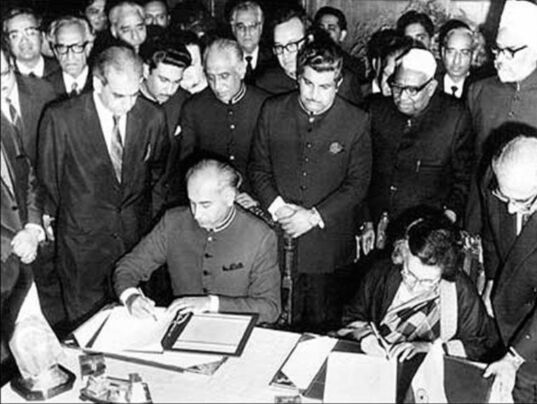Acquiescence: A mirage in Kashmir?
Attempts of reconciliation over Kashmir issue inched closer with Dixon and Shimla agreements but the end remained an unfulfilled hope due to mutual disagreement and hostile media among other reasons

Even as the stalemate in the UN continued, a bilateral agreement between India and Pakistan was signed in Karachi in July 1949. Both countries agreed to abide by the ceasefire line to be supervised by UN military observers under the auspices of the United Nations Commission for India and Pakistan (UNCIP). The ceasefire line stood the test of time, and even after the 1965 war, both countries agreed to abide by it at the time of signing of the Tashkent Agreement by Prime Minister Shastri and General Ayub Khan. Had Shastri not died suddenly after signing the agreement, there could have been follow-up discussions towards a lasting settlement, for by all accounts the personal chemistry between the two leaders was quite positive. After the decisive Indo-Pak war of 1971, which led to the creation of Bangladesh, the two sides came to the table in Shimla and, amidst much bonhomie, the Shimla Agreement was signed between Indira Gandhi and Zulfikar Ali Bhutto. India and Pakistan signed an agreement to resolve their differences bilaterally, without any external reference, and defining a Line of Control in Kashmir. The 'essence' of the Shimla Agreement lies in the second clause, which reads:
'The two countries are resolved to settle their differences by peaceful means through bilateral negotiations or by any other peaceful means mutually agreed upon between them. Pending the final settlement of any of the problems between the two countries, neither side shall unilaterally alter the situation nor shall both prevent the organization, assistance or encouragement of any acts detrimental to the maintenance of peace and harmonious relations'.
While India continues to hold the Shimla Agreement as sacrosanct, Bhutto himself reneged on it. Naturally, his successors have refused to accept the cardinal principle of settling the issue bilaterally, and have tried to raise it in the UN, as well as in Organization of Islamic countries.
Hardly had the agreement been signed when the Pakistani Prime Minister Zulfikar Ali Bhutto, who had never hidden his intention to make Pakistan a nuclear power, began disparaging India. Writing in the 'Foreign Affairs' magazine in April 1973, Bhutto disingenuously observed that "Pakistan had been the victim of unabashed aggression: her eastern part seized by Indian forces. It was this fact that made it difficult for our people to be reconciled to the fait accompli, more so because the invasion was not an isolated phenomenon. On the contrary, it was but the climax of a long series of hostile and aggressive acts by India against Pakistan since the establishment of the two (nations) as sovereign and independent states".
However, with all his oratorical and demagogic skills, Bhutto was ousted in a military coup and the Shimla Agreement became a dead letter.
It must be placed on record that this was the closest the two nations ever got to after the failure of Dixon Plan in 1950. Dixon was a well-respected Australian jurist, chosen by the United Nations to mediate between India and Pakistan on the J&K issue. He tried to settle the issue after his field-level observations in all the regions of the state. The Dixon plan assigned Ladakh to India and northern areas and Pakistan-occupied Kashmir to Pakistan, besides splitting Jammu between the two countries. It proposed a plebiscite in the Kashmir valley. In many ways, this reflected ground position as half of Poonch, Mirpur and Muzaffarabad were in PoK. According to Dixon, there was no need to go in for a plebiscite for the entire state, because of the clear demographic divide along geographical lines.
While Pakistan was almost willing to accept the plan, India had serious reservations about handing over the territory that must be handed over to the UN administration. This would have meant that Sheikh Abdullah would have to abdicate during the period. Neither Nehru nor Abdullah were willing for this; they insisted that for this to happen, the Pakistan Army must withdraw from all the areas which were part of J&K on August 15, to which Pakistan was not agreeable.
However, Dixon's failure cannot wholly be ascribed to disagreement between India and Pakistan because in the aftermath of the Nehru Liaquat Pact, it appeared that India and Pakistan were inching towards some understanding of each other's position. Dixon could have also showed greater patience and sagacity, and given more time for his ideas to sink in, but like Radcliffe, he was also a man in a hurry, and got quite exasperated with the 'continuing and endless dialogues'
In hindsight, the main culprits then, as now seems, were the aggressive media on both sides of the border. While the English newspapers did write editorials supporting the plan, the Urdu and the Hindi press took an absolutely partisan approach, thereby negating whatever gains could have been made through negotiations and diplomatic parleys.
Views expressed are personal



